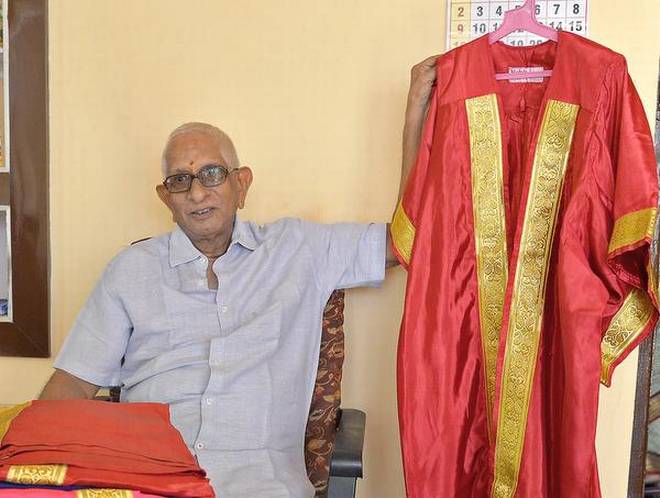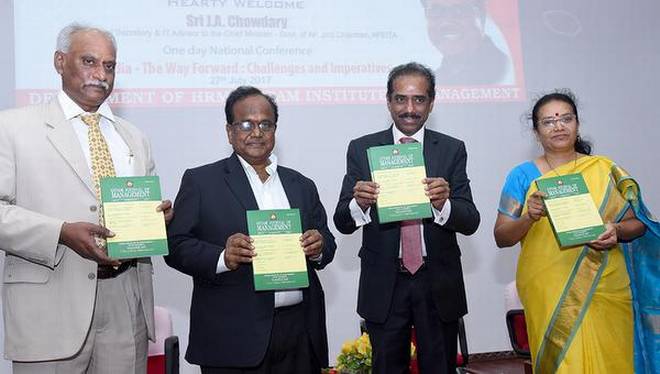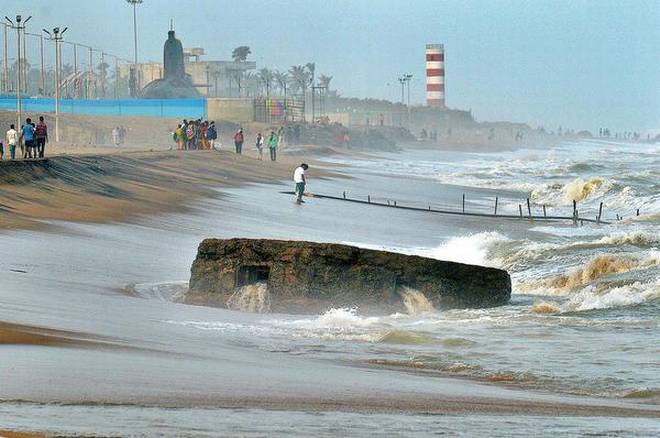Monthly Archives: July 2017
32
31
30
The man behind the convocation gown

The octogenarian has been supplying the special garment since 1959
Year after year, M.S.R. Murty has been an integral part of the jubilation of scores of graduates who pass out on the convocation day wearing black ceremonial robes, flinging their black scholars’ hats into the air.
Since 1959, the 80-year-old has been supplying the black gowns for the convocation of the Andhra University and 50 other colleges in the districts of Visakhapatnam, Vizianagaram and Srikakulam.
Celebrity customers
From former President Sarvepalli Radhakrishnan and former Prime Minister Indira Gandhi to actors like ANR and Bhanumathi to former cricketer Sunil Gavaskar, several important personalities have worn the gowns made by Mr. Murty, a known name in the university and college circles of the city.
Ahead of the 83rd and 84th combined convocation of the University, the octogenarian is filled with nostalgia as he goes down the memory lane to share some priceless moments.
“In those days, AU convocation used to be a big affair and meticulously held every year on the second Saturday of December. We had a tailoring unit at our book store in the One Town area, where the black gown with golden border used to be stitched,” says Mr. Murty, who took over his father’s business in 1959. Till about a decade ago, the gowns used to be stitched at the tailoring unit in the city. However, a dwindling interest in tailoring business made it difficult for him to get the work done by local tailors.
He now gets the gowns made from a Chennai-based unit. This year, he is supplying as many as 1,100 gowns for the convocation.
The first film celebrity to don his gown was ANR when he was conferred the honorary doctorate degree of ‘Kalaprapoorna’ by the AU in the 70s. Later, it was during Indira Gandhi’s visit the tradition of the ceremonial gown was changed to silk scarves.
“That particular year, I was ready with gowns when hardly 20 days ahead of the convocation I was informed about the change. I had to rush to Mumbai to get the silk cloth for the scarves and managed to make 100 scarves in a span of a week’s time. Ms. Gandhi was very particular about protocol and there were elaborate arrangements and practice done to avoid any chance of even minor goof-ups. I made a special velvet scarf for Ms. Gandhi for the convocation where she was conferred D. Litt. ,” recollects Mr. Murty.
Age has certainly not withered him as he gets ready for Saturday’s convocation with two separate sets of gowns – the black ones for the graduates and the coloured ones for VIPs.
“The gowns are given on rent for ₹150 and I charge a caution deposit of ₹1,000 from each student, which is refunded once the gowns are returned,” says Mr. Murty, who also supplies gowns for convocation of other colleges and universities like GITAM University and Damodaram Sanjivayya National Law University.
With his children settled in their respective careers, Mr. Murty continues his family business with diligence in his twilight years.
source: http://www.thehindu.com / The Hindu / Home> News> States> Andhra Pradesh / by Nivedita Ganguly / Visakhapatnam – July 27th, 2017
‘Vizag set to turn hub for blockchain tech’

$1 billion challenge contest soon
Special Chief Secretary and IT Adviser to the Chief Minister J.A. Chowdary on Thursday said the State government was keen on developing Visakhapatnam as a hub for blockchain technology, in its bid to overcome challenges posed by reverse globalisation and disruptive technologies.
He was addressing a conference on ‘Skill India – the way forward: Challenges and imperatives’ organised by GITAM University.
Mr. Chowdary said AP Electronics and IT Agency (APEITA), an autonomous institute formed by the government, had tied up with GITAM University and Broadridge of the United States to introduce job-ready courses in blockchain technology.
He said J.C. Bose Institute of Cryptology would set up a centre in Visakhapatnam.
Stating that Visakhapatnam was being promoted as a Fintech Valley, he said they would organise a $1 billion blockchain challenge contest in the city sometime in October, to bring companies specialising in blockchain here and the best selected would be provided with the space to start their operations.
He said the spectre of jobless growth was haunting the country and therefore the Andhra Pradesh Government was promoting IT technologies, such as blockchain tech, cyber security and analytics to tap huge job potential.
Capgemini India CEO Srinivas Kandula complimented the State government for its bold initiative in promoting new age technologies.
Skill gap
Calling for recasting the curriculum by the educational institutes to roll out industry-ready professionals Mr. Srinivas pointed out that most of the engineering graduates in the country did not have the requisite skills and the companieswere being forced to impart training on them.
GITAM University Pro Vice-Chancellor K. Siva Rama Krishna and principal of GITAM Institute of Management P. Sheela spoke.
source: http://www.thehindu.com / The Hindu / Home> News> States> Andhra Pradesh / by Special Correspondent / Visakhapatnam – July 28th, 2017
26 / b
World War II bunkers cry for attention

They should be restored and turned into museums, say historians
A silent reminder of a significant chapter of Visakhapatnam’s maritime history, the World War – II pill boxes or bunkers dotting the shores of the coast, resurfaces every year during monsoon when the eroded sands uncover these concrete structures hidden beneath for decades.
Lack of any effort to restore and conserve these historical concrete fortifications, vagaries of nature over the years and public apathy have left these pill boxes in a state of utter neglect, serving as a painful reminder of an earlier time, slowly crumbling back into the sea.
Maritime history
At a time when the Tourism Department in association with the district administration is making efforts to create a maritime museum circuit along the beach road, these vintage pill boxes cry for attention. According to historians and retired naval personnel, these pill boxes are a significant link to the maritime history of the region, which should be restored and included in the maritime historical circuit at the Beach Road where the latest addition is the upcoming museum project of the decommissioned TU 142 fighter aircraft.
Speaking to The Hindu, (Retd.) Cdr B.L.N. Rao, secretary of Navy Foundation – Visakhapatnam Chapter, said: “There are four such pill boxes spotted along the Vizag coast. The one at R.K. Beach is still in good shape and can easily be retrieved. Once it resurfaces from the sand, iron sheets can be kept all around it, the remaining sand can be dug till the base of the structure and with the help of hydraulic jack it can be lifted and shifted.”
Last year, Cdr. Rao had initiated efforts in the restoration of these critical historical pill boxes by taking the VUDA officials around the locations where they are seen. “Nothing much has been done after that,” he said.
The pill box at the R.K. Beach is about 20 to 30 feet wide and 10 feet high. “Similar dimensions of pill boxes exist near Kotaveedhi and Lavender Canal. However, the one near the fishing colony of Jalaripeta is nearly four times the size of the others and is beyond repair. That one was used as the command control centre by the British,” he added.
As conflict in the World War II ramped up, these pill boxes were used to fortify the shores by the British to resist invasion by Japan. According to researchers, most of them were constructed around 1938-1941.
Old timers recollect the presence of another pill box opposite the Naval Coastal Battery which they say was “mercilessly razed to the ground” in the 1960s when the road was being built. “These defence constructions were considered to be highly confidential during WW-II. Hence, there is no proper documentation of the number of bunkers present along the Vizag coast,” said historian Edward Paul.
But recently these secret bunkers have piqued the interest of historians, war veterans and enthusiasts alike – and more people are attempting to discover their locations.
“Proper signage at the locations of the pill boxes can go a long way in showcasing the maritime history of the region,” Mr. Paul added. While efforts to restore a similar British-era bunker discovered inside the Raj Bhavan in Mumbai are being taken, in other parts of the world – the most recent one being in Denmark’s western coast, World War II bunkers have been transformed into museums.
source: http://www.thehindu.com / The Hindu / Home> News> States > Andhra Pradesh / by Nivedita Ganguly / July 24th, 2017